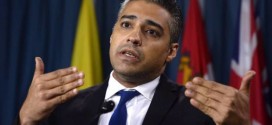By Fatima Syed
Welcome to Canada. We lied about the opportunities.
That is the realistic undertone to the new immigration policy announcement by Citizenship and Immigration Minister Chris Alexander on October 31, 2014, which declared that Canada aims to welcome as many as 285,000 new permanent residents next year.
Statistics Canada found 14 per cent of university-educated immigrants who've come to Canada in the last five years are without a job
The last time Canada admitted as many as 280,000 permanent residents was in 2010. According to the Minister, this is the highest planned total
"in recent history," and is designed to "
attract skilled immigrants" who will "
help contribute to our economy and labour market."
There's nothing new in this policy announcement. Canada has been successfully attracting "
skilled immigrants" since the 1980s when the Canadian government began opening their doors to doctors, lawyers and engineers from all parts of the word. Today the nation is one of the most multicultural societies in the world.
Sorry, let's be accurate. It's one of the most multicultural societies in the world with a great divide between immigrant and Canadian-born when it comes employment, according to a Statistics Canada Labour Force Survey.
See, what the Minister fails to mention is that Statistics Canada found 14 per cent of university-educated immigrants who've come to Canada in the last five years are without a job. He forgets to highlight that unemployment levels for recent immigrants with university degrees has hit their highest point since June, 2010. He forgets to tell us that university-educated newcomers earn an average of 67 per cent of the amount their Canadian-born, university-educated counterparts do.
The fact is that Canada is failing to deliver on a promise to use, what Minister Alexander called in a speech "
higher-calibre" immigrants to "
contribute to [its] economy and labour market." Sadly, this is a promise that has been made time and again with no results. The streets of this nation are populated with taxi drivers who have PhDs, corner shop owners with engineering careers and administrative assistants with Masters in Education.
A study of 50,000 Canadian cab drivers entitled '
Who Drives a Taxi in Canada', found that 200 are doctors with PhDs, compared with 55 of their Canadian-born counterparts. Twenty per cent have undergraduate or master's degrees, compared with four per cent of Canadian-born drivers. The majority had backgrounds in business, engineering and architecture.
It seems unethical to attract the most educated and accomplished citizens of some of the least well-off places in the world, then deny them the opportunities they're promised at the door once they've unpacked.
Canadian immigration has become a game of hide-and-seek. First you hide the realities of professional immigrant life. Let's tuck away the employer bias of hiring only English-named applicants with Canadian education and experience. Let's put out of sight the modest alternatives left for "skilled immigrants" to fill: the hourly-wage, the low-level positions, the months and months of resume-sending, waiting and disappointment.
Then you seek the finest crop, the "
high-calibre" individual who will fit the criteria and the numbers, but not the dreams and hopes they bring. The closet full of skeletons that says otherwise is locked up, the key safely hidden for now.
In the late 1960s-1970s, waves of new immigrants were needed to fill the professional roles: doctors, engineers and such. One has to wonder what's changed since then. What has necessitated the need for "
high-calibre" immigrants today? The context behind the government's policy announcement seems to be absent. Is it an announcement for the sake of maintaining Canada's open-doors image? Or is it an announcement arising from some economic/labour plan we are yet aware of?
It seems unethical to attract the most educated and accomplished citizens of some of the least well-off places in the world, then deny them the opportunities they're promised at the door once they've unpacked. It seems immoral to put the nearly 80 per cent of skilled workers with university degrees who immigrated between 2000 and 2007 through the economic hardships without any policy of integration or recognition.
If the federal government wants to welcome more would-be Canadians, they must also look into an overhaul of the current system. The need for a Canadian labour market that values international education, professional experience and language ability on an equal footing is long overdue. This is not a new suggestion, but it is a suggestion that is yet to be considered in immigration policy.
There are 285,000 new immigrants who will come to Canada next year.
That's 285,000 new immigrants who will arrive in Canada to end up low-paid or jobless next year, if the trend shown above continues.
The truth about their prospects won't be in the fine print of their permanent resident application. It won't be in their welcome brochure.
![]()
About the author
Fatima Syed is a Master of Journalism Student at Ryerson University, interested in all the stories not covered and not asked about by the mainstream news. You can follow her at @fatimasyed4
 The Arab Democrat The Latest From The Arab World
The Arab Democrat The Latest From The Arab World






